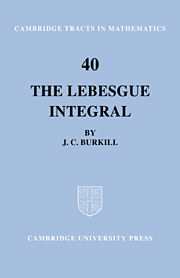Summary
My aim is to give an account of the theory of integration due to Lebesgue in a form which may appeal to those who have no wish to plumb the depths of the theory of real functions. There is no novelty of treatment in this tract; the presentation is essentially that of Lebesgue himself. The groundwork in analysis and calculus with which the reader is assumed to be acquainted is, roughly, what is in Hardy's A Course of Pure Mathematics.
It has long been clear that anyone who uses the integral calculus in the course of his work, whether it be in pure or applied mathematics, should normally interpret integration in the Lebesgue sense. A few simple principles then govern the manipulation of expressions containing integrals.
To appreciate this general remark, the reader is asked to turn to p. 42; calculations such as are contained in Examples 4–8 might confront anyone having to carry through a mathematical argument. Consider in more detail Example 4; the result has the look of being right rather than wrong, but the limiting process involved is by no means simple, and the justification of it without an appeal to Lebesgue's principles would be tiresome. Anyone with a grasp of these principles will see that the easily proved fact, that (1 –t/n)nincreases to its limit e–l, ensures the validity of the passage to the limit.
Information
- Type
- Chapter
- Information
- The Lebesgue Integral , pp. v - viPublisher: Cambridge University PressPrint publication year: 1951
